Archive for January, 2008
January 23, 2008 at 10:57 pm · Filed under Home base, Roadtrips
Just north of Tucson are the Santa Catalina Mountains, and up into those mountains is a road called the Catalina Highway. If you follow that road about 29 miles you will find yourself a lofty 8,000 feet above sea level. It’s an incredible thing, to depart the warmth of Tucson and arrive at a ski area — the southernmost ski area in North America — in less than an hour, with snow and pine trees and log cabin chalets everywhere.
The Catalinas are an example of “sky islands” which dot southern Arizona. By sticking up abruptly in the desert they create ecosystems that contain all the things you’d find a thousand miles north of here. I’ve wanted to go up to the highest point in the Catalinas, called Mt Lemmon, ever since we decided to settle in the area, and today I finally got a chance.
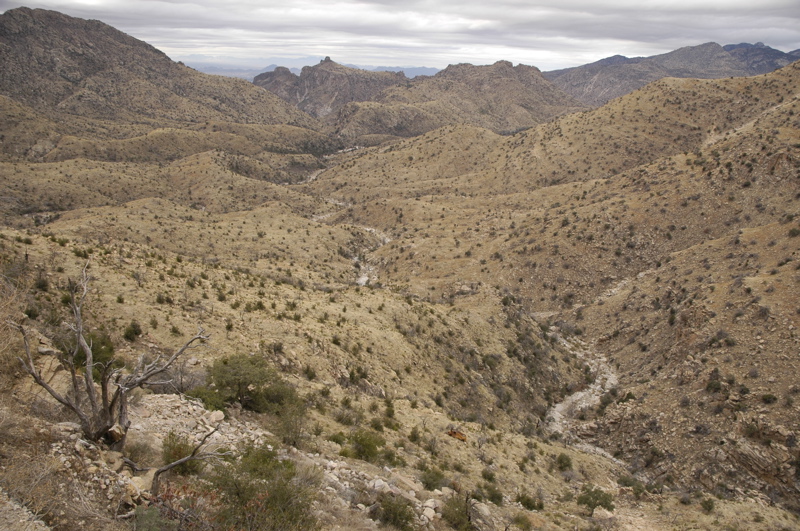
The road itself is a marvel. It twists and climbs through 5,000 feet in just a few miles, providing spectacular views from overlooks along the way. Half a dozen campgrounds are available too, although only one can accommodate RVs over 22 feet long. Several are for tents only. They look terrific for a hot summer day, located above 4,000 feet where the saguaros no longer can grow but where pine trees thrive.
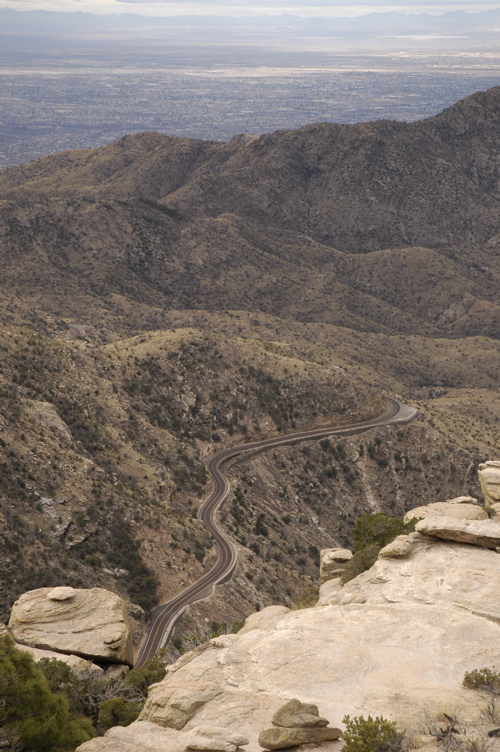 Although the first half of the route looks dry (and is, much of the year), there are numerous perennial waterfalls. Hiking trails are everywhere, or you can just drive from pullout to pullout and take in the views.
Although the first half of the route looks dry (and is, much of the year), there are numerous perennial waterfalls. Hiking trails are everywhere, or you can just drive from pullout to pullout and take in the views.
Above 8,000 feet there are numerous “cabins” on leased land in the National Forest. A lot of these cabins have been expanded to ridiculous size and made into (apparently) year-round homes. They form a small town called Summerhaven, which consists of one short main street, a few retail shops (general store, pizza parlor, gift shop, real estate office), and lots of residences either newly built or under construction. In 2003 there was a devastating forest fire up there, and so half the residences are being rebuilt, and it seems that money is no hindrance in many cases.
Near the center is a short spur road that leads to Mt Lemmon’s summit, the ski area and the ski area’s restaurant. The ski area is closed Tuesday and Wednesday even this time of year. It’s not a large place but it’s all we’ve got down here in southern Arizona. We’re lucky to have a ski area at all.
Being up there, I felt like I was back in Vermont or perhaps somewhere in Colorado. The clouds were blowing through and the temperature was in the upper 20s or low 30s at best. Crusty snow was everywhere. I had to remind myself that only 29 miles down the hill we’d be back in Tucson, AZ.
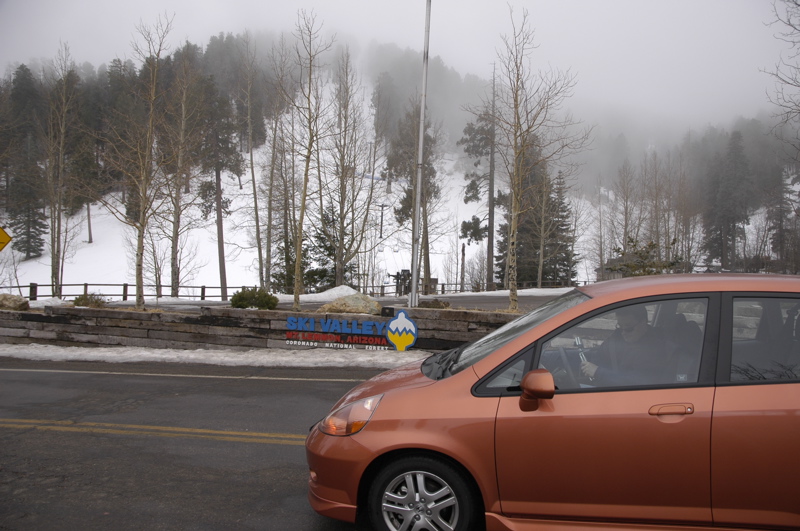
 This evening we went out for Vietnamese food, which was great, but they’ve started supplying fortune cookies like Chinese restaurants. When fortune cookies are handed out, I always seem to get the lamest fortune. This was no exception.
This evening we went out for Vietnamese food, which was great, but they’ve started supplying fortune cookies like Chinese restaurants. When fortune cookies are handed out, I always seem to get the lamest fortune. This was no exception.
What does this strange little slip of paper mean to tell me? Is this good fortune or a prediction of a long and difficult life? Does this have anything to do with the fact that Eleanor doesn’t tow the trailer? And what do I win at the end?
One other thing: a couple of weeks ago we launched the Airstream Life Media Community. It’s a free service which allows you to share Airstream-related photos and videos with other people. There are already about 70 photos uploaded and several videos, and I’d like to encourage more. Check it out and upload your favorite Airstream pictures or even short videos! The more, the merrier!
January 22, 2008 at 8:19 pm · Filed under Home base, Places to go
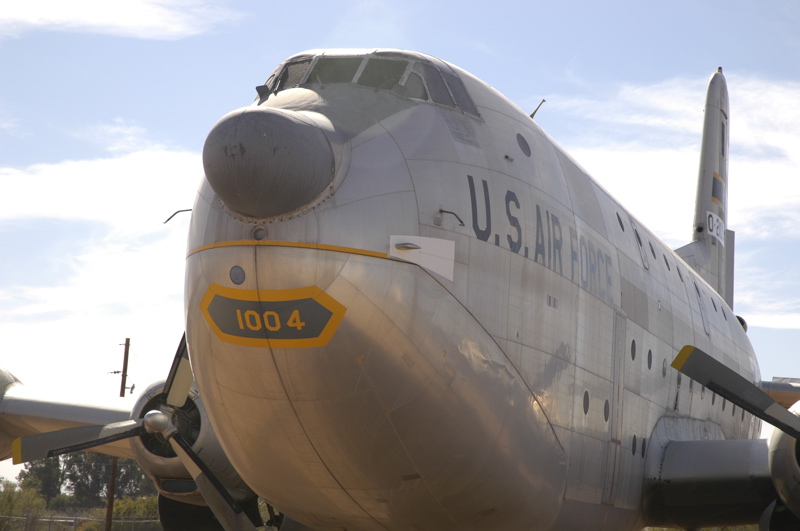
There are a lot of aircraft smiling at the Pima Air & Space Museum, despite the fact that they don’t fly anymore. They must like retirement.
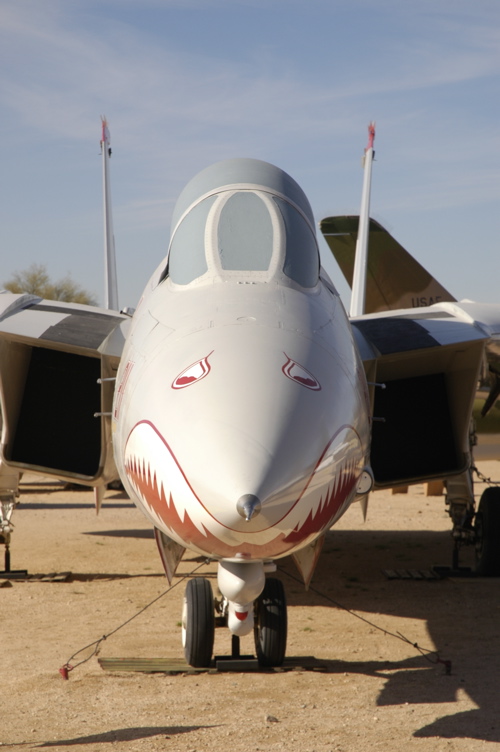
I’ve visited the museum before (see blog entry here) , but with over three hundred aircraft and four major buildings, it deserves a second visit. It’s one of the best aviation museums in the USA.
It’s also a great place to take pictures, and we aren’t the only ones to realize that. Halfway through our visit, 450 photographers from a convention showed up and mobbed the place with enormous cameras, reflectors, and even a couple of models.
Fortunately there’s a lot of acreage for everyone. When the photogs arrived we were about to hop on the bus for the other great attraction associated with PASM: the 309th Aircraft Maintenance and Regeneration Group, better known as “the boneyard.”
You can get a peek at the boneyard for free just by driving up Kolb Blvd in Tucson. But if you want to get a guided tour of the place, it’s an extra $6. Since it is part of an active military facility, there’s an ID check and nobody can get off the bus, but the tour is great. There are hundreds of amazing aircraft to be seen, in seemingly endless rows. Some of them are mothballed for future use, some are being parted out, others (like B-52 bombers) are being chopped up and left in the sun for Russian satellites to observe under the terms of the SALT II agreement.

A fraction of the 309th AMARG — click for larger
The boneyard also has all the dies needed to build B-1B bombers, should the decision ever be made to start production of them again. Those dies alone take up several acres of space. Then there are the rows of F-16s, A-10s, T-37s, F-14s, and a few one-of-a-kind aircraft. For a warbird or aviation geek, it’s a really cool tour. At the end of it, we were grinning like the aircraft.
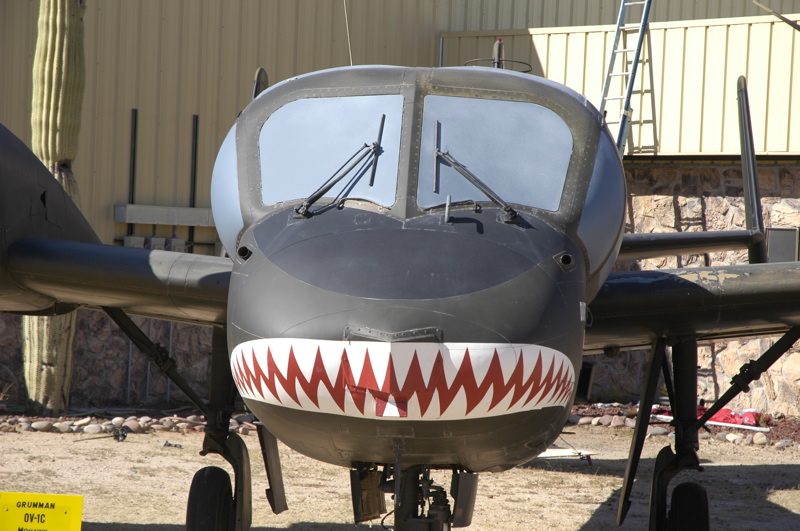
January 22, 2008 at 7:31 pm · Filed under Eleanor's posts
Why I Don’t Tow!
(a rant inspired by fellow blogger Jill’s post and a subsequent comment to her post)
to read Jill’s post and the comment, go to:
http://airstreamlife.com/amoveablefeast/2008/01/13/8/
People continually confront me with the fact that for over two years of full time travel I have never towed the Airstream. Their astounded tone of voice quickly turns to one of accusation and disdain. How could I not share in such an arduous task? (We have crossed this country seven times – that’s a lot of towing.) What if Rich were to get sick? What if there was an emergency? How would we survive if I can’t tow? In their eyes I am villainous! Most of the individuals who can not comprehend my refusal to tow have never traveled long distances with a child in the car. Most of them have never traveled full time while still working. None of them have been married to Rich.
First and foremost, when we were conceptualizing our tour, I told Rich I would not tow and he accepted that fact. If my husband is OK with me not towing, then it doesn’t matter what anyone else thinks. I could end this post right here. But I won’t. You see, I’m feeling slightly self righteous this morning, so let me set the record straight! It’s not a matter of can vs. can’t, it’s can vs. won’t.
I can tow. I won’t tow!
When Rich is sick, we stay put until he is well. (Do you go to your husband’s place of employment and perform his job when he is ill? No. He calls in sick and resumes his responsibilities when he is well.)
When there is an emergency, we do not tow our 30′ Airstream to the hospital with us! And yes, I know how to unhitch. (Do you take your Airstream with you when you need to see a doctor? I seriously doubt it.)
If we were to encounter a health emergency so critical that there was no time to unhitch, I would not be towing, I’d be dialing 911. (I hope you would have enough common sense do the same!)
Sitting in the front passenger seat, I am more than the driver’s travel companion, I am the other passenger’s travel companion as well. When we are in the car I help navigate, but mainly, I entertain Emma when she is bored. She was only five when we started our life of travel and hated being in the car, so this was a full-time job before she could read. She still hates being in the car, but now she can read to herself. DVD’s and GameBoy are strictly limited by Rich (not more than two hours of either in a day), so it still makes my interaction quite necessary. If Rich were in the front passenger seat, he would work on his laptop or talk on his cell phone, or he would try to nap. I would still be in charge of Emma’s dilemmas.
When we arrive at our destination, I help to back in with hand signals. Rich sets us up outside, and I am responsible for the inside of the trailer. Once we are settled in, Rich usually goes right to work on the magazine. Our life is not 9 to 5. We are not retired. We are not on an extended vacation. The Airstream is our home, office, and classroom. I am Emma’s school teacher. I am her playmate – she has no siblings. I am always a mother and a wife. I am the one who prepares and cooks dinner and does the dishes. Rich can’t cook. I help Emma bathe and get ready for bed. My day doesn’t end when the driving ends.
We have a clear division of responsibilities and my responsibilities do not include towing.
January 21, 2008 at 10:17 pm · Filed under Places to go
Since we are expecting to be residents of this area eventually, we need to figure out the popular sights for our occasional out-of-town guests. Living in Vermont, we accumulated dozens of brochures and guides of things to do in the area, and I bound all of the loose items in a three-ring binder entitled, “There’s Nothing To Do Here.” This proved popular with our occasional visitors, since we only included the good stuff and tried to mix in a lot of lesser-known but fun things based on our years living there.
Brett is our first official house guest, since he is sleeping on an inflatable mattress in the living room, and so he is also our first guinea pig. It is a little tricky advising him on things to see and do here since we have lived here only for about three months in total, and most of that time was spent either looking for a house or fixing it up. But I do know a few good spots near town and I pointed him in the right direction, then followed while he snapped pictures of cactus and canyons.
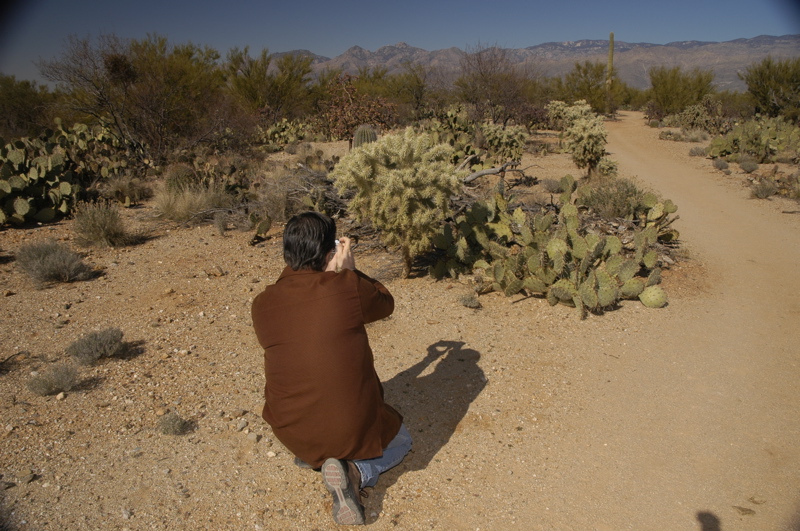
Saguaro National Park is one of the first places I’d point anyone who is interested in the desert. The second place is Sabino Canyon (a national forest site). Both are only a few miles from our house. Above, Brett is learning about the cacti that grow here. That’s a “teddy bear cholla” that he’s photographing. Also in the picture are saguaro, barrel cactus, prickly pear, mesquite trees and palo verde trees.

Sabino Canyon is another outdoor site not to be missed. The road is closed to vehicles but there’s a tram that runs you up the canyon, or you can walk or bicycle. If you have a national parks pass you get admission to both Saguaro NP and Sabino Canyon for free. We arrived after 4:30, too late to take the tram. There are always lots of people walking to road until sunset, so we just joined them and hiked a couple of miles up the canyon before turning back.
The hills around Sabino are filled with saguaro cactus, so many that they form a desert forest. People expecting the desert to look like the Sahara are inevitably surprised at all the things that live here. Along the way if you listen carefully you may hear the soft chuckling and hooting of Gambel’s Quail, an funny little bird with a tuft on its head. They run across the road on tiny feet, hardly ever flying, in small groups. People from out of town often assume they are roadrunners, but roadrunners are much bigger and look completely different.
Sabino Canyon contains a stream that flows much of the year. It was running today, filled with cold water from snow melting high up in the Santa Catalinas. The stream is a reminder that the desert isn’t completely devoid of water, it’s just drier than other areas.
As we walked back down the road after sunset, the full moon rose above the walls of the canyon, which was a nice surprise. From all these experiences, I think that Brett discovered today how beautiful the desert can be. By taking him around to see these places, I’ve also been reminded of the reasons why I’ve been attracted to the desert as well. So having occasional guests to show around is good for us too.

January 20, 2008 at 8:58 pm · Filed under Uncategorized
About 30 miles south of Tucson is the town of Green Valley, where our friends Ken and Petey live three months of the year. They come down with a different Airstream every year, since they have a collection of vintage ones. Their collection includes some really spectacular trailers, including a 1948 Airstream Wee Wind, and the one-of-a-kind smallest Airstream ever made, named “Der Kleine Prinz”.
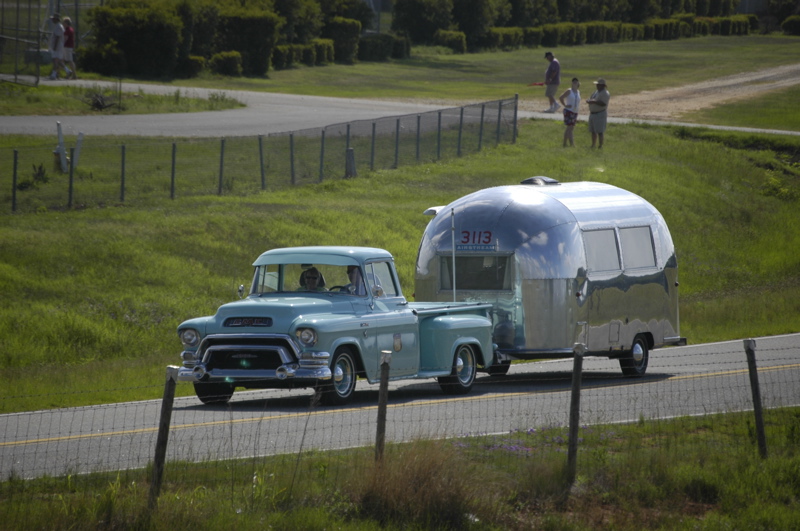
Ken and Petey also have a nice 1965 Airstream Caravel, which they took to the International Rally last summer in Georgia (above). We went to Puerto Penasco (Sonora, MX) last spring with them, and that time they brought their 1960s-era Globe Trotter.
This weekend we met up with photographer/author Doug Keister and his wife Sandi at Ken & Petey’s condo for brunch. You might recall we courtesy-parked at the Keister’s house last November.
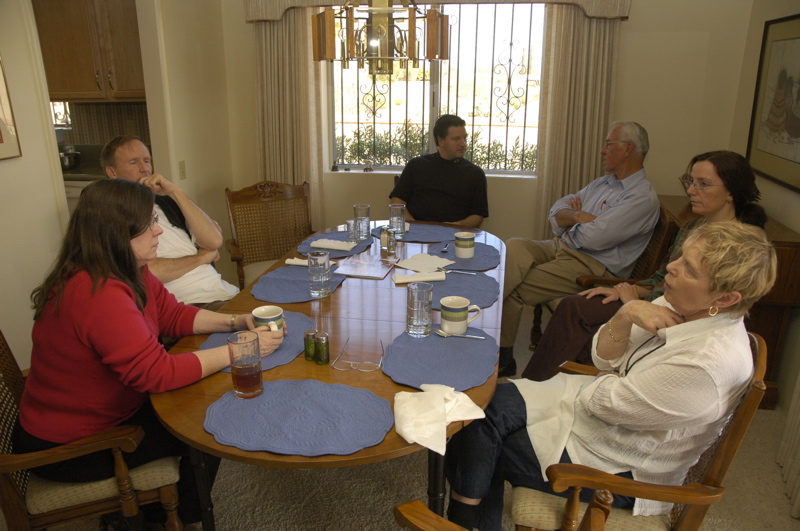
Getting together a group with this much vintage trailer knowledge is always interesting. Brett has owned and restored several vintage trailers and motorhomes. Ken is habitually restoring trailers, and Doug has written numerous books on vintage RVs. In fact, his next one is coming out this spring, and we plan to carry it in the Airstream Life store.
It’s also helpful to talk to Doug about photography, since he knows more about it that I’ll ever know. Together with Bert Gildart, he has convinced me to add a few tools to my camera equipment. But of course, the real problem is finding the budget. I’d like to get a spare Nikon digital SLR body, preferably a D80, and I’m still looking for the Nikon 18-200mm VR zoom, the Tokina 12-24mm zoom, and an SB-800 flash. That’s about $3k in total. Some day …
January 19, 2008 at 10:56 pm · Filed under Home base
We’ve moved a few times in our lives, but I have never had as much fun getting to know a place as I am having discovering Tucson. It’s an interesting place, despite the near-rabid attempts by local real estate developers to turn every square inch into a chain retail store. Like a lot of desert communities, Tucson has had a healthy share of local oddities, western lore, and quirky individuals. I’m trying to find them all before they disappear forever.
One such place is the Valley of the Moon. This is a special little fantasy park for children, made by a very special person decades ago. It’s in serious danger of closing forever. Today (Jan 19) the foundation that administers the park held an open house to try to save it. Click the link above and read the story of George Phar Legler — it’s inspirational.
Another such place is the last drive-in theater in Tucson. It’s called the De Anza drive-in, and it has been on the chopping block for a while, as out-of-state land owners wait for Tucson real estate prices to rise enough to make a profit by turning it into yet another shopping center. They’ve been waiting since 1997.
The De Anza was once one of a dozen drive-ins in Tucson, but of course they’ve all closed over the decades. Now the De Anza is surrounded by the city’s sprawl, but it still shows a double feature every night. We’ll go there sometime in the next two weeks, because you never know …
Think I’m paranoid? Well, when we bought our house in May there was a neat old mini-golf place a couple of miles away, called Magic Carpet Golf. We made a mental note to drop in on it and play a round among the old-time statues and corny sets. But when we got back this December, we found the Magic Carpet Golf had closed. Recent reviews have not been kind to it, but it was a Tucson institution for decades, and it’s a shame to see it gone. There’s still a chance the statues will be saved, however, thanks to active members of Vanishing Tucson group (on Yahoo).
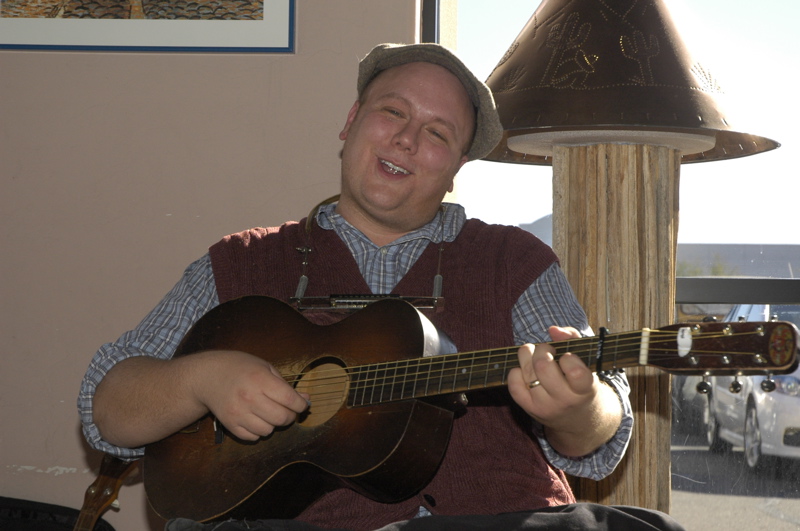 Today Emma and I went over to see Jack Norton, “The Man From Mullet River” perform at a local coffee shop. I happened upon Jack during an Internet search for ukulele music in Tucson. He does a fun show with his banjo, guitar, ukulele, harmonica and an amazing invisible trumpet. Jack is sort of a one-man revival of vaudeille music, and I like to see people who keep neat old things alive. I’ll even buy his CD. (But don’t be too flattered, Jack. I have the same respect for people who sustain lines of heirloom vegetables.)
Today Emma and I went over to see Jack Norton, “The Man From Mullet River” perform at a local coffee shop. I happened upon Jack during an Internet search for ukulele music in Tucson. He does a fun show with his banjo, guitar, ukulele, harmonica and an amazing invisible trumpet. Jack is sort of a one-man revival of vaudeille music, and I like to see people who keep neat old things alive. I’ll even buy his CD. (But don’t be too flattered, Jack. I have the same respect for people who sustain lines of heirloom vegetables.)
Brett arrived today, which was great because we haven’t seen him in a while, and because it caused us to get serious about making the house habitable. Eleanor got busy cleaning the bathroom of plaster remnants, hanging shower curtains, and picking the scraps of vinyl floor and old sinks out of the tubs. We now have two usable bathrooms, albeit without cabinets or sinks yet. The giant refrigerator is stocked with cold drinks and all the things we couldn’t fit into our little Airstream refrigerator over the past two years, and we have wood for the fireplace. This house is starting to become home.
January 18, 2008 at 5:51 pm · Filed under Travel / lifestyle musings
When does life become perfect?
It is part of human nature to strive for more. Once our basic needs are satisfied, we look for improvements. Few of us are permanently satisfied with what we have, a trait that is well exploited by marketers who offer bigger houses, quieter dishwashers, and tastier frozen pizzas.
I have long been one of those who is always looking around the next corner for something else, which motivates both travel and entrepreneurial business ventures. This has cost me quite a lot of money in mistakes and lost salary. I would probably be financially better off if I had stuck to my last nine-to-five job, but long ago I conceded that I am unable to sit still and leave “well enough” alone.
But now I sense an internal settling occurring, and having a house to live in (at least once it is finished) seems to be bringing those feelings to the surface for analysis. I am not sure if this is symptomatic of aging. Perhaps internal hormones that first manifested at age 13 are finally settling down; perhaps this is part of the fact that I am now into my mid-40s (I can’t believe I even typed that, it feels entirely like I am speaking of someone else). I am, as a teacher once said to me, on that “long slow slide” that begins sometime after the late 30s.
It is disheartening when viewed as a phenomenon of physical deterioration (knees weakening, brain not as sharp as it once was) and yet there are small benefits. As the joke goes, having Alzheimer’s means you can forget all your troubles. In my case, I am finding the prickly edges of my personality wearing down. I’m worrying less and looking at things differently. Being 40-something means you can sometimes get respect from the Gen X 30-somethings who work for you, and not be looked down on too badly by the “silver fox” capitalists who own everything. It’s a good middle position to work from, like being a Junior in high school.
There is no doubt that our travels have helped along my gradual transformation. Two years in an travel trailer ought to be required of all citizens of this country, like military service in other countries. Not only would it be good for the environment, since full-time RV’ers consume only a fraction of the resources of stationary folks, but it would give more people the opportunity to broaden their views and appreciate how much they don’t need. As a country our values might shift for the better.
I feel like I’m at a turning point. It’s the culmination of a long process that began sixteen years ago when Eleanor and I bought our first house together, a gigantic money pit Victorian house in Massachusetts. With a huge mortgage payment and an impossible list of essential repairs staring at me, I quit my day job two months later and started my own company, the same company that publishes Airstream Life magazine today. It was a huge, seemingly insane first step down the road that has led me here.
I remember sitting in my first home office, an 8×9 room furnished with a simple desk and a view to the street through two permanently fogged windows, and listening to a Holly Cole covering “I Can See Clearly Now”. On the Internet, I had found a simple A-frame house for sale, atop a hill near Austin TX in a place where you could see the stars through clear skies, and the views were panoramic from the front and rear decks. I used to look at the pictures of that house and listen to that song and think, “Someday…”
My internal clock is telling me that today is “someday”. We ended up in the desert rather than the hill country, and we have a daughter who wasn’t part of the program back in 1993, and I’m certainly not wealthy, but overall the process worked. Eleanor and I have gained experience, matured a little, won and lost a few battles. I feel like we’ve achieved a sense of who we are and what makes us feel right. Life is not perfect but after decades of tromping around looking for perfect it has become obvious that this may be as good as it gets.
Travel-wise the tables have been turned on me lately. I spoke to Bert Gildart today; he and Janie are in Needles CA heading for Anza-Borrego Desert State Park and they asked if we could join them. In six hours we could be there in the Airstream, but we need to stay here for a while. Not only do we have house stuff to do, but a round-trip to Anza-Borrego would cost about $200 in fuel. As full-timers we didn’t look at trips that way since we rarely made round-trips, but now suddenly we are the house-bound folks with obligations on our time. Ouch.
I shall comfort myself with the knowledge of travel yet to come. In February I will be going to Las Vegas for a few days, and I hope to work up a trip to Sonora as well. We have several visitors coming, which may inspire at least a weekend or two nearby, too.
« Previous entries ·
Next entries »
 Although the first half of the route looks dry (and is, much of the year), there are numerous perennial waterfalls. Hiking trails are everywhere, or you can just drive from pullout to pullout and take in the views.
Although the first half of the route looks dry (and is, much of the year), there are numerous perennial waterfalls. Hiking trails are everywhere, or you can just drive from pullout to pullout and take in the views. This evening we went out for Vietnamese food, which was great, but they’ve started supplying fortune cookies like Chinese restaurants. When fortune cookies are handed out, I always seem to get the lamest fortune. This was no exception.
This evening we went out for Vietnamese food, which was great, but they’ve started supplying fortune cookies like Chinese restaurants. When fortune cookies are handed out, I always seem to get the lamest fortune. This was no exception.












